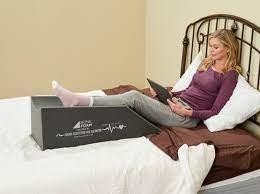A client who is 7 days postpartum calls the provider's office and reports pain, swelling, and redness of her left calf. Besides the client seeing the provider, which of the following interventions should the nurse suggest?
Massage the area.
Apply cold compresses
Flex the knee while resting
Elevate the leg
The Correct Answer is D
Choice A rationale:
Massaging the area is not recommended because the client's symptoms could indicate a possible deep vein thrombosis (DVT), and massaging could dislodge a clot and cause harm.
Choice B rationale:
Applying cold compresses is not recommended if DVT is suspected, as it could potentially worsen the condition.
Choice C rationale:
Flexing the knee while resting is not recommended if DVT is suspected, as it could potentially worsen the condition and increase the risk of a clot traveling to the lungs (pulmonary embolism).
Choice D rationale:
Elevating the leg can help reduce swelling and improve blood flow. However, the client should still see the provider for further evaluation of possible DVT.

Nursing Test Bank
Naxlex Comprehensive Predictor Exams
Related Questions
Correct Answer is B
Explanation
Choice A rationale: A positive contraction stress test warrants immediate attention and evaluation. Waiting for 24 hours to repeat the test could delay necessary interventions in case of fetal distress.
Choice B rationale: A positive contraction stress test indicates that there are late decelerations in the baby's heart rate during contractions, which may suggest fetal distress. In such cases, it is essential to admit the client to the hospital for further evaluation, monitoring, and appropriate management.
Choice C rationale: Checking the client's cervix for dilation is not the most appropriate action in response to a positive contraction stress test. Fetal well-being and assessment take priority in this situation.
Choice D rationale: A positive contraction stress test requires further action and should not be considered a routine finding. Proper management and evaluation are necessary when the test results are positive.
Correct Answer is B
Explanation
Choice A rationale: While it's true that newborns can have irregular breathing patterns, this response may come across as dismissive and not addressing the client's concerns.
Choice B rationale: The nurse should respond by actively listening to the client's concerns and offering to assess the newborn's breathing while they are feeding. Newborns can have irregular breathing patterns, including periods of rapid breathing (tachypnea) and pauses in breathing (periodic breathing). These patterns are generally normal and related to the baby's immature respiratory system adjusting to life outside the womb.
Choice C rationale: This response does not address the client's concern about the baby's breathing and instead focuses on the client's potential as a mother.
Choice D rationale: This response may minimize the client's concerns and does not address the baby's breathing issue. It's essential to acknowledge and assess the newborn's breathing pattern to ensure it is within the normal range.
Whether you are a student looking to ace your exams or a practicing nurse seeking to enhance your expertise , our nursing education contents will empower you with the confidence and competence to make a difference in the lives of patients and become a respected leader in the healthcare field.
Visit Naxlex, invest in your future and unlock endless possibilities with our unparalleled nursing education contents today
Report Wrong Answer on the Current Question
Do you disagree with the answer? If yes, what is your expected answer? Explain.
Kindly be descriptive with the issue you are facing.
